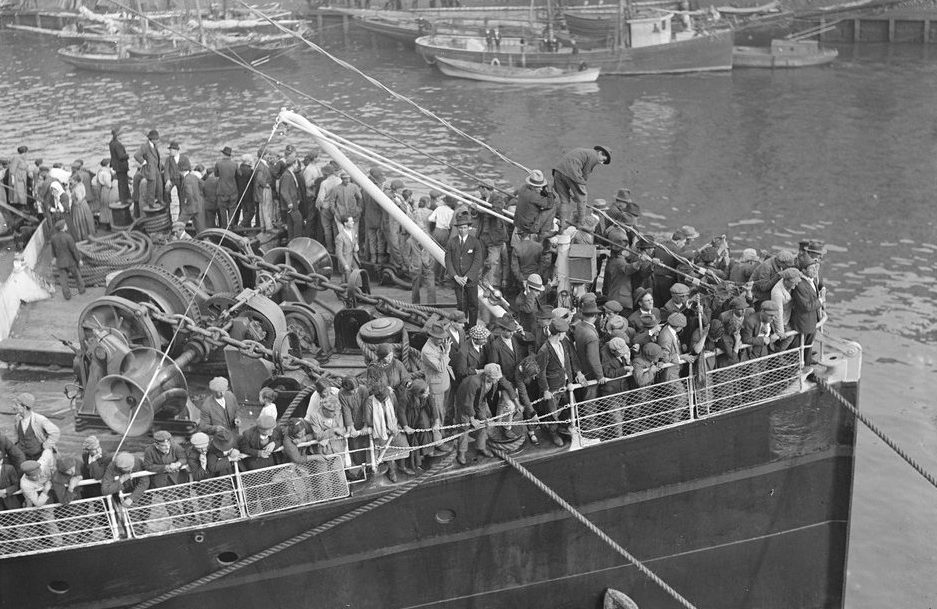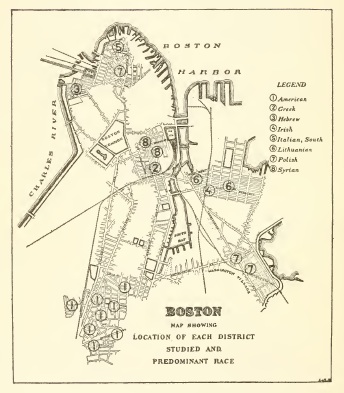S.S. Canopic lands in Boston, 1920. Photo by Leslie Jones, courtesy of the Boston Public Library.
During the late nineteenth and early twentieth centuries, Boston’s industrial economy matured and expanded across the region. New manufacturing plants were built along the city’s main railroad lines, and new subway and streetcar lines fueled the building of homes and factories in adjoining suburbs. The city of Boston itself continued to grow, more than doubling its population between 1880 and 1920. The foreign born made up 36 percent of those residents in the 1910s—the city’s peak immigration decade. Together with their native-born children, immigrants made up nearly three-quarters of Boston’s population.
Industrial development in North America and Western Europe had ripple effects on local economies across the globe. As cheaper manufactured goods displaced local crafts, artisan livelihoods suffered in places like Ireland, the Mediterranean, and Eastern Europe. Overpopulation, agricultural crises, heavy taxation, and political and religious repression added to the pressures that drove many to leave. With so many countries now sending emigrants abroad, Boston’s foreign-born population gradually shifted. Although the Irish continued to be the city’s largest foreign-born group, Canadians, Russian Jews, and Italians all formed large communities by the early twentieth century. Smaller streams of migrants also came from China, Portugal, Poland, Lithuania, the Ottoman Empire, and the West Indies.
Newcomers took up residence in the city’s established immigrant quarters in the North, South, and West Ends as many earlier Irish settlers left. Some of the latter, along with the native and German-born working class, relocated to outlying neighborhoods such as South Boston, Jamaica Plain, Roxbury, Dorchester, East Boston, and Charlestown. Social workers referred to these areas as “the zone of emergence”—places where skilled white immigrant workers and their families were settling alongside other ethnic groups and aspiring to middle-class standards of living. By the 1910s, newer immigrant groups would also begin moving to these areas as well as to fast-growing industrial suburbs such as East Cambridge, Chelsea, Somerville, Watertown, Malden, Quincy, Waltham, and Framingham.
As in the first wave, many second wave male immigrants worked as day laborers on the streets, docks, and railroads. Moreover, construction work building new roads, bridges, subways, and streetcar lines was especially important in this period. Irish women continued to work in domestic service, but were gradually replaced by newcomers from Eastern Europe and black migrants from the South. Overwhelmingly, though, second wave immigrants—both men and women—found jobs in local factories making shoes, garments, textiles, rubber goods, chemicals, candy, and other products. The reorganization and mechanization of such industries meant that higher-paid skilled workers could be replaced by unskilled immigrant workers earning significantly lower wages. The hours were long, and working conditions were often grueling and hazardous. To avoid the factory regime, some immigrants worked as peddlers, selling produce or dry goods on the streets. The most successful earned enough to start their own groceries or other retail businesses, and immigrant entrepreneurship thus became a common path of upward mobility. (Continue reading on the Restriction Era, 1924-1965)


